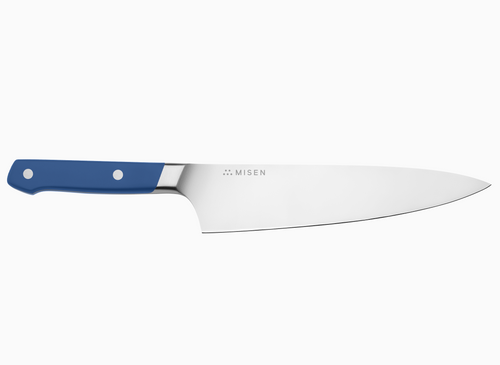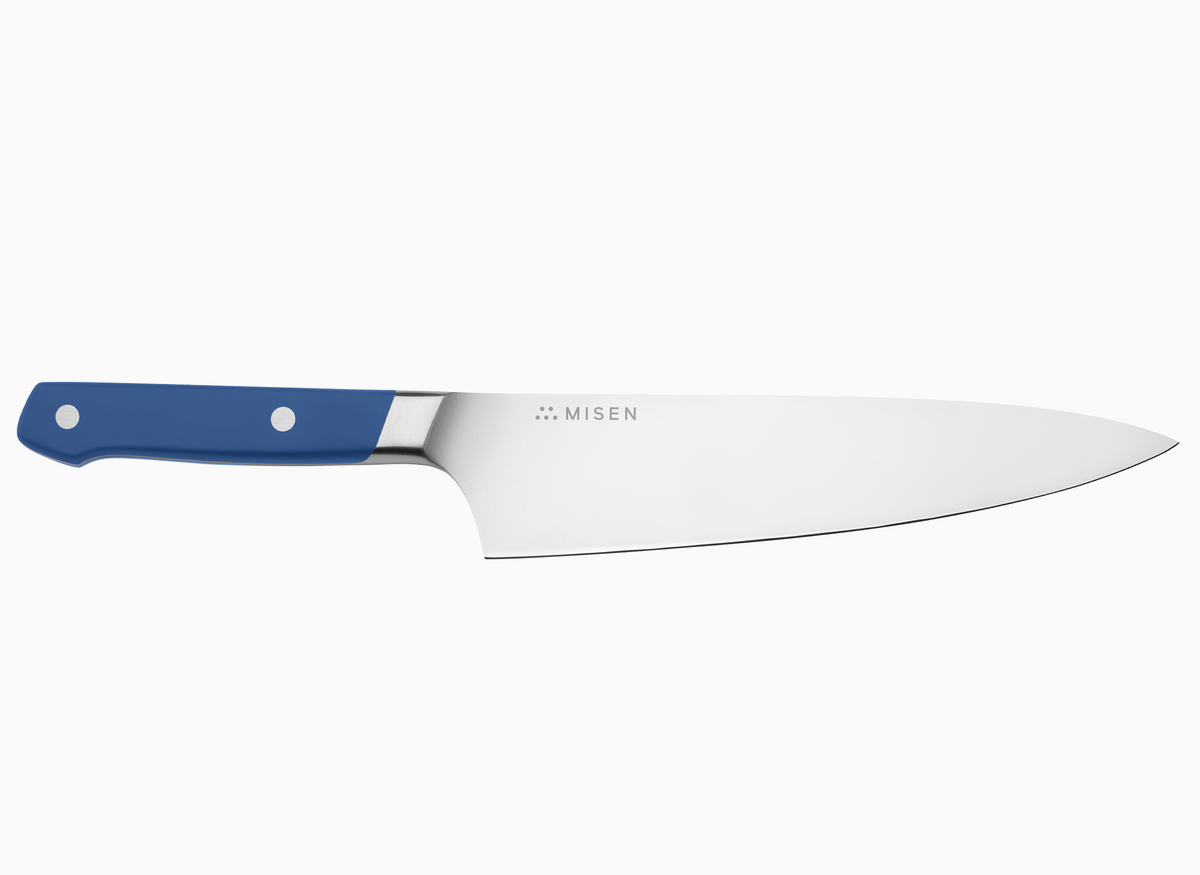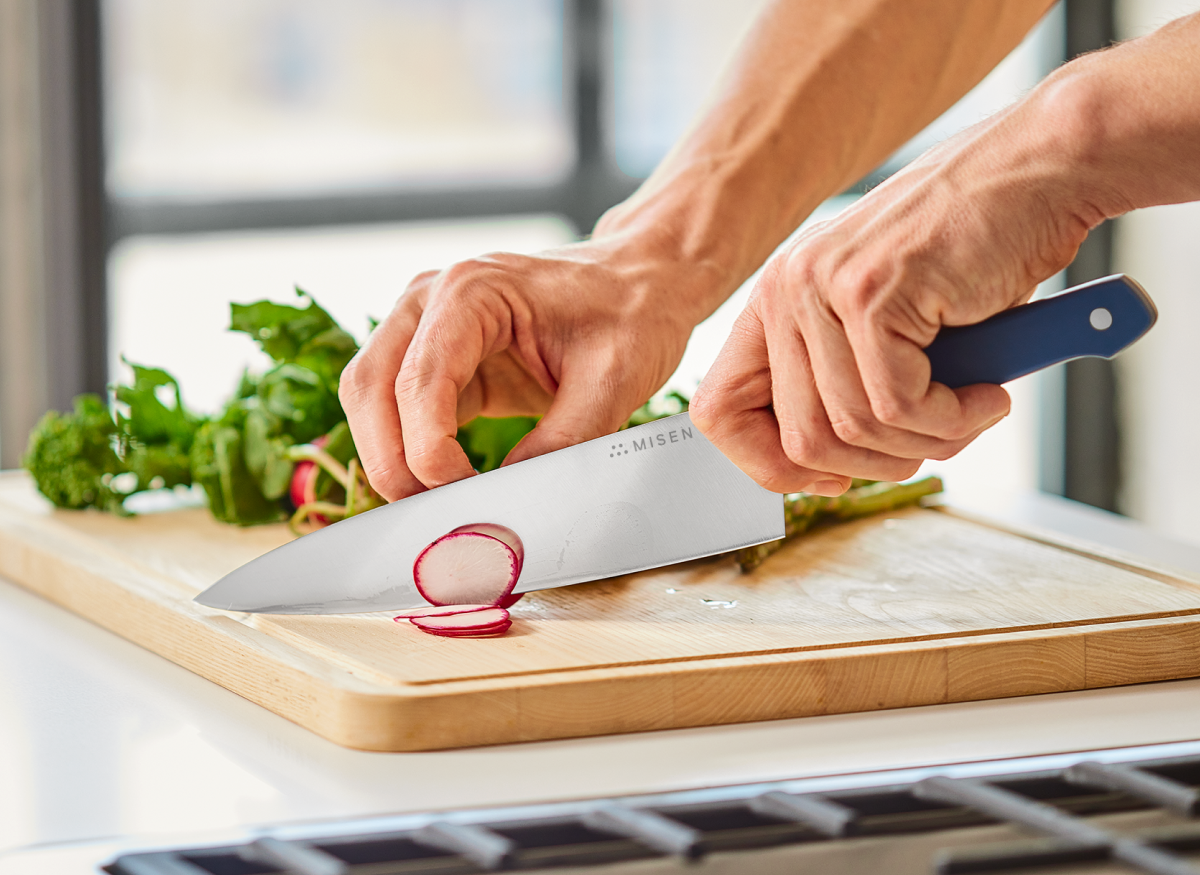Can Knife Sharpening Wear Down the Blade?
 Sharpening removes a small portion of the knife blade.
Sharpening removes a small portion of the knife blade.
- A dull knife is a safety hazard.
- Honing and sharpening aren’t the same thing.
- Sharpening removes the old edge and creates a new one.
We want our kitchen knives to be sharp. They’re more efficient and easier to use with a razor-sharp edge. So, it’s easy to see why you might think you should re-sharpen them before each use. When it comes to sharpening quality kitchen knives, there really can be too much of a good thing.
Sharpening a knife is an aggressive process. It removes a small amount of steel each time. You would start to see the consequences if you did this prior to every use of your kitchen knives. There’s a way to maintain a sharp edge on your knife that doesn’t require frequent re-sharpening. It’s called honing. To understand why you don’t want to sharpen a knife unless it’s necessary, let’s look at the difference between knife sharpening and knife honing.
Sharp Is Good for You
A dull knife is bad news for you and the food you’re preparing. For you, it means additional strain on your hands, arms, and back. The blade’s dull edge requires you to exert more force to make a cut. So if your fingers get in the way, they can get more seriously injured. The possibility of a serious cut is why you need to pay attention to an exceptionally sharp chef’s knife.
But there’s also reason to pay close attention to a dull knife. It might even be more of a safety risk. A dull knife is more likely to slip than a sharp knife. And a cut produced by a dull knife will take longer to heal because of the damage it does at a cellular level.
Vegetable Cruelty
 A dull knife robs your vegetables of nutrition.
A dull knife robs your vegetables of nutrition.
A dull knife’s higher level of cellular damage is also bad news for the vegetables and fruit you prepare. Have you ever noticed smudges on the cutting board the same color as the food you’re chopping? It’s because your dull knife is crushing cells instead of slicing between them. It’s also why a sufficiently sharp knife can create paper-thin tomato or cucumber slices without producing a pool of liquid.
You struggle less. Your food retains more nutrition. So it’s worth the maintenance that goes into preventing your kitchen knives from getting dull. But your knife doesn’t necessarily need to be re-sharpened just because it’s not showing that insolent tomato who’s boss. It might just need some quick maintenance.
Honing
A quality knife manufacturer will always recommend you purchase a honing steel. This rod-shaped knife maintenance tool is sometimes confusingly called a knife sharpening steel.
What is accurate in both cases is that it’s made of steel that’s harder than your knives. Or, it might be made of ceramic — a substance harder than steel, but so brittle that it’s easy to break or shatter if you drop it. The true purpose of a honing steel is to take care of the thing that’s keeping your sufficiently sharp knife from making clean slices. Here’s what’s preventing this.
The very edge of the blade — the part that cuts — is called the burr. It’s so thin that you really can’t see it without the help of a microscope, and that view might surprise you. The burr is anything but uniform or smooth. It’s made of irregular microscopic jagged edges called teeth. Because the burr is so thin, it’s also pliable.
With everyday use, the blade’s burr will fold over, just like a piece of paper. The very edge of the blade is still there and still very sharp, but it’s been tucked under or at least bent at an angle that prevents it from meeting the food head-on. Your knife remains quite sharp, but it will behave as if the blade is dull. It doesn’t need to be re-sharpened. That super thin cutting edge just needs to be realigned.
Your honing steel provides this realignment. At this point, re-sharpening the blade would be overkill. You’d be using an abrasive method to grind the steel blade, which removes a small amount of the metal to reestablish the blade’s sharpness.
Instead, gently slide the blade along the honing steel. Match the angle of the edge. You’ll realign or smooth out the folded-over edge. Honing doesn’t remove any steel. It just straightens out the tucked edge.
Even a couple of minutes of rapid mincing is enough to knock your knife’s microscopic razor-sharp edge out of alignment. Follow these tips for proper use of a honing steel (sometimes known as a sharpening steel).
Sharpening
 Chopping herbs with a dull knife will leave green residue on your cutting board.
Chopping herbs with a dull knife will leave green residue on your cutting board.
Over time, honing your knife won’t be enough to get it to make efficient cuts. Too many of the burr’s microscopic teeth have broken away. It’s time to create a new burr by using abrasive material to remove the old one. Your honing steel isn’t capable of doing this. This time, you really are going to remove part of the blade.
Let’s be realistic: You’re not going to see a noticeable difference if you re-sharpen your chef’s knife. Correctly done, the sharpening process removes only enough steel from the blade to reestablish the burr. So, don’t be concerned about miniaturizing your knives if it’s truly necessary to re-sharpen them.
We suggest sharpening your knives once or twice a year. We even offer to do it for you.
Knife Sharpening Machines
The easiest and fastest way to restore a razor-sharp edge on a kitchen knife is to take it to a professional. High-end stores like Sur la Table and Williams Sonoma offer this service. Often, they’ll offer to sharpen one knife for free if you bring in several.
These retail stores might use one of the products they sell to sharpen your knives: a knife sharpening machine. Sharpening machines use abrasive spinning disks set at precise angles to remove enough steel to quickly establish a new burr. More of the blade is removed than necessary, and it’s why you should only re-sharpen a kitchen knife this way when you’re certain that honing is insufficient.
It might be electric, but you also can purchase manual knife sharpening machines. Both types feature at least two slots where you’ll place the knife blade, and pull or push it through. The first slot will feature a coarse abrasive. It will remove steel as you pull or push it through. Follow the instructions. Pulling or pushing the blade through more than the recommended number of times will not make it sharper, but it will remove more of the blade’s steel.
After this first slot, any remaining ones will expose the blade to a finer abrasive. The last, finest setting will remove any lingering steel remnants that might have been created by the passes through the first, coarse slot.
Don’t substitute the fine slot for honing your knives. Remember, the honing steel isn’t abrasive and won’t remove any blade material. The fine grit used in the slot of a sharpening machine is still aggressive enough to remove steel.
Knife sharpening machines are easy to use because they remove most of the guesswork. You just have to make the determination that your knives really do need to be re-sharpened — meaning it’s time to remove some steel to create a new edge.
The edge is dependent on the angle on both sides of the blade. Be sure to purchase a knife sharpening machine matching the type of knives you own. Japanese-style knives have delicate and more acute angles for a sharper edge (10-15 degrees). German-style knives offer more durability with a 20-30-degree angle. You wouldn’t want to sharpen your Japanese-style knife in a machine configured for German-style cutlery and vice versa.
Sharpening Stones
Sharpening stones will also restore a razor-sharp edge on your knives, but the process is more gradual. The tradeoff is superior results and less worry about wearing your knife down.
There’s a learning curve involved. You’re not pulling or pushing the knife blade through a series of slots. Instead, you’re using a series of abrasive blocks sometimes called whetstones. Each stone has a grit or level of coarseness. For convenience, look for opportunities to buy a combination of sharpening stones featuring a coarse, medium, and fine grit stone.
Grit refers to the size of the particles in the sharpening stone. For example, a 220-grit stone has particles that are 60-100 microns in size. A 6,000-grit sharpening stone features particles that are less than 5 microns. A lower grit number means the stone is more abrasive and best for blades that are dull or damaged. A high grit stone finishes the job of smoothing and polishing the new sharp edge.
Sharpening stones need lubrication to help the steel of your knife blade glide smoothly across the surface. That lubrication is usually either water or oil. It’s why these knife sharpening stones are sometimes referred to as — you guessed it — water stones or oil stones. The stone’s manufacturer will recommend which of these lubricants you should use. Most people find that using oil to lubricate a sharpening stone is a messy proposition. If you have the option, choose water. Cleanup is easier.
Knife Sharpening Systems
It’s not difficult to learn how to use sharpening stones, and this less aggressive method of creating a new burr produces better results than a knife sharpening machine. The challenge for some is that it takes practice and diligence to make sure you’re always holding the knife at the correct angle as you move it across the sharpening stone.
It’s why some people choose to use what’s known as a knife sharpening system. It’s a collection of additional tools that help you find and maintain the correct angle for the knife blade. When you think of this approach, it might be easier to call it what it really is: a guided knife sharpening system.
The advantage is that you have guidance in using sharpening stones to restore your knife’s edge. The disadvantage is that while the systems are helpful, they often take time to set up.
Sharpening to Last a Lifetime
 Honing won’t remove any of the blade’s steel, and you can do it in less than a minute.
Honing won’t remove any of the blade’s steel, and you can do it in less than a minute.
Most of us don’t keep microscopes in our kitchens, so it’s often not possible to visibly determine if a knife has lost enough of its teeth to need a new burr or if the blade simply needs to be honed so the teeth are realigned.
Start with honing. It won’t remove any of the blade’s steel, and you can do it in less than a minute. If the knife continues to cut like it’s dull, that’s because it truly is dull. It needs to be re-sharpened.
There’s only one way to successfully re-sharpen a knife blade. You have to use something abrasive to remove an extremely small amount of steel from the edge of your knife and reestablish the burr. You won’t wear down your blade if you sharpen a knife only when necessary. And if you use a honing steel regularly on your quality knives, it’ll be less often than you think.








